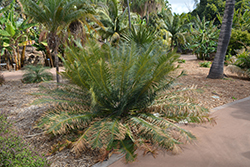Fri & Sat 8am - 8pm
Sun 8am - 7pm
Anytown, USA 12345
fax: 261.787.0463
e-mail: info@successgc.com


Plant Finder

Height: 20 feet
Spread: 8 feet
Sunlight:
![]()
![]()
Hardiness Zone: 9b
Other Names: syn. Cycas jenkinsiana
Description:
A very symmetrical plant with dark green, leathery leaves that resemble feathers; trunk is very low in young plants, but lengthens with age; very slow growing, and may eventually branch; a beautiful accent or container plant
Ornamental Features
Himalayan Sago Palm features showy spikes of tan flowers held atop the branches in mid fall. It has attractive dark green evergreen foliage. The large glossy narrow pinnately compound leaves are highly ornamental and remain dark green throughout the winter. The fruits are showy orange drupes which fade to red over time, which are displayed from mid to late winter. The rough dark brown bark adds an interesting dimension to the landscape.
Landscape Attributes
Himalayan Sago Palm is an evergreen tree with a strong central leader and a towering form, with a high canopy of foliage concentrated at the top of the plant. Its relatively fine texture sets it apart from other landscape plants with less refined foliage.
This tree will require occasional maintenance and upkeep, and should not require much pruning, except when necessary, such as to remove dieback. It has no significant negative characteristics.
Himalayan Sago Palm is recommended for the following landscape applications;
- Accent
- Mass Planting
- General Garden Use
- Container Planting
Planting & Growing
Himalayan Sago Palm will grow to be about 20 feet tall at maturity, with a spread of 8 feet. It has a high canopy with a typical clearance of 7 feet from the ground, and is suitable for planting under power lines. As it matures, the lower branches of this tree can be strategically removed to create a high enough canopy to support unobstructed human traffic underneath. It grows at a slow rate, and under ideal conditions can be expected to live to a ripe old age of 100 years or more; think of this as a heritage tree for future generations! This is a dioecious species, meaning that individual plants are either male or female. Only the females will produce fruit, and a male variety of the same species is required nearby as a pollinator.
This tree does best in full sun to partial shade. It does best in average to evenly moist conditions, but will not tolerate standing water. It is not particular as to soil pH, but grows best in sandy soils. It is somewhat tolerant of urban pollution. Consider applying a thick mulch around the root zone in winter to protect it in exposed locations or colder microclimates. This species is not originally from North America, and parts of it are known to be toxic to humans and animals, so care should be exercised in planting it around children and pets.
Himalayan Sago Palm is a fine choice for the yard, but it is also a good selection for planting in outdoor pots and containers. Because of its height, it is often used as a 'thriller' in the 'spiller-thriller-filler' container combination; plant it near the center of the pot, surrounded by smaller plants and those that spill over the edges. It is even sizeable enough that it can be grown alone in a suitable container. Note that when grown in a container, it may not perform exactly as indicated on the tag - this is to be expected. Also note that when growing plants in outdoor containers and baskets, they may require more frequent waterings than they would in the yard or garden.
